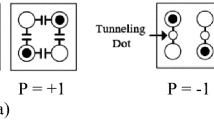Abstract
Considering the limitations of CMOS technology, the Quantum-dot Cellular Automata (QCA) is emerging as one of the alternatives for Integrated Circuit (IC) Technology. A lot of work is being carried out for design, fabrication and testing of QCA circuits. In this paper, we have worked on defect analysis, fault models development and deriving various properties for QCA Majority Voter (MV) to effectively generate the test patterns for QCA circuits. It has been shown that unlike CMOS technology, single missing cell consideration is not enough for QCA technology. We have presented that the Multiple Missing Cell (MMC) defect, which is very natural at nanoscale, causes the sizable difference in functionality compared to Single Missing Cell consideration described in literature, and hence, must be considered while test generation. The proposed MMC is supported by exhaustive simulation results as well as kink energy based mathematical analysis. Further, Verilog fault models are proposed which can be used for the functional, timing verification and activation of faults caused by MMC defect. The effect of MMC on output is analyzed in stand-alone MV as well as when MV is a part of circuit. At the end, we have proposed the test properties of MV when being used as MV itself, as AND gate or OR gate. These properties may be further helpful in development of test generation algorithms.













Similar content being viewed by others
References
Amlani I, Orlov AO, Kummamuru RK, Bernstein GH, Lent CS, Snider GL (2000) Experimental demonstration of a leadless quantum-dot cellular automata cell. Appl Phys Lett 77(5):738–740
Chen K, Maezawa K, Yamamoto M (1996) Inp-based high-performance monostable-bistable transition logic elements (MOBILE’s) using integrated multiple input resonant-tunneling devices. IEEE Electron Dev Lett 17 (3):127–129
Dhare V, Mehta U (2015) Defect characterization and testing of QCA devices and circuits: a survey. In: Proc of 19th international symposium on VLSI design and test, pp 1–2
Dhare V, Mehta U (2015) Fault analysis of QCA combinational circuit at layout & logic level. In: Proc of IEEE International WIE conference on electrical and computer engineering, WIECON, pp 22–26
Dhare V, Mehta U (2016) Development of basic fault model and corresponding ATPG for single input missing cell deposition defects in majority voter of QCA. In: Proc of IEEE region 10 conference, TENCON, pp 2354–2359
Dysart TJ, Kogge PM, Lent CS, Liu M (2005) An analysis of missing cell defects in quantum-dot cellular automata. In: Proc. of IEEE international workshop on design and test of defect-tolerant nanoscale architectures, NANOARCH pp 1–8
Huang M, Momenzadeh FL (2007) Analysis of missing and additional cell defects in sequential quantum-dot cellular automata. Integr VLSI J 40(1):503–515
Jing Huang M, Momenzadeh MB, Tahoori F (2004) Lombardi: defect characterization for scaling of QCA devices. In: Proc of 19th IEEE international symposium on defect and fault tolerance in VLSI systems, pp 30–38
Lent CS, Snider GL (2014) The development of quantum-dot cellular automata. Field coupled nanocomputing, LNCS. Springer, pp 3–20
Lent CS, Taugaw PD (1993) Lines of interacting quantum-dot cells: a binary wire. J Appl Phys 74:6227–6233
Lent CS, Tougaw PD (1997) A device architecture for computing with quantum dots. Proc IEEE 84(4):541–557
Lent CS, Tougaw PD, Porod W, Bernstein GH (1993) Quantum cellular automata. Nanotechnology 4(1):49–57
Lent CS, Taugaw PD, Porod W (1994) Quantum cellular automata: the physics of computing with arrays of quantum dot molecules. In: Proc of workshop on physics and computing, pp 5–13
Likharev K (1999) Single electron devices and their applications. Proc IEEE 87(4):606–632
Liu M, Lent C (2007) Reliability and defect tolerance in metallic quantum-dot cellular automata. J Electron Test 23(3):211–218
Meindl J (2003) Beyond Moore’s law: the interconnect era. Comput Sci Eng 5(1):20–24
Momenzadeh M, Ottavi M, Lombardi F (2005) Modeling qca defects at molecular-level in combinational circuits. In: Proc of 20th IEEE design for test, DFT, pp 208–216
Orlov AO, Amlani I, Bernstein GH, Lent CS, Snider GL (1997) Realization of a functional cell for quantum-dot cellular automata. Sci Mag 227:928–930
Peercy P (2000) The drive to miniaturization. Nature 406(6799):1023–1026
Porod W, Lent CS, Bernstein GH, Orlov AO, Amlani I, Snider GL, Merz JL (1999) Quantum-dot cellular automata: computing with coupled quantum dots. Int J Electron 86(5):549–590
Schulhof G, Jullien WK (2007) Simulation of random cell displacement in QCA. ACM J Emerg Technol Comput Syst (JETC) 3(1):1–14
Tahoori M, Momenzadeh M, Huang J, Lombardi F (2004) Testing of quantum cellular automata. IEEE Trans Nanotechnol 3(4):432–442
Tahoori MB, Momenzadeh M, Huang J, Lombardi F (2004) Defects and faults in quantum cellular automata at nano scale. In: Proc of 22nd IEEE VLSI test symposium, VTS, pp 291–296
Toth G, Lent CS (1999) Quasiadiabatic switching for metal-island quantum-dot cellular automata. Appl Phys Lett 85(5):2977–2984
Tougaw P, Douglas CS (1994) Lent: logical devices implemented using quantum cellular automata. J Appl Phys 75(3):1818–1825
Walus K, Dysart TJ, Jullien GA, Budiman RA (2004) Qcadesigner: a rapid design and simulation tool for quantum-dot cellular automata. IEEE Trans Nanotechnol 3(1):26–31
Yang XK, Cai L, Wang SZ, Wang Z, Feng C (2012) Reliability and performance evaluation of QCA devices with rotation cell defect. IEEE Trans Nanotechnol 11(5):1009–1018
Zhang Y, Lv H, Liu S, Xiang Y, Xie G (2015) Defect-tolerance analysis of fundamental quantum-dot cellular automata devices. Article in The Journal of Engineering, 1–6
Acknowledgements
We are thankful to Dr. K. S. Dasgupta, Director, DAIICT, Gandhinagar, India, Dr. Manoj Singh Gaur, Director, IIT, Jammu, India and Dr. Virendra Singh, Associate Professor, IIT, Bombay, India for their valuable guidance.
Author information
Authors and Affiliations
Corresponding author
Additional information
Responsible Editor: M. B. Tahoori
Rights and permissions
About this article
Cite this article
Dhare, V.H., Mehta, U.S. Multiple Missing Cell Defect Modeling for QCA Devices. J Electron Test 34, 623–641 (2018). https://doi.org/10.1007/s10836-018-5766-1
Received:
Accepted:
Published:
Issue Date:
DOI: https://doi.org/10.1007/s10836-018-5766-1




